On the Mode I and Mode II Delamination Characteristics and Surface Morphological Aspects of Composites with Carbon-Thermoplastic Hybrid Fabrics and Innovative Liquid Thermoplastic Resin
Abstract
1. Introduction
2. Materials and Manufacturing
2.1. Materials
2.2. Manufacturing
3. Experimental Details
3.1. Double Cantilever Beam/Mode I Fracture Toughness Test
3.2. End Notched Flexure/Mode II Fracture Toughness Test
4. Results and Discussions
4.1. Double Cantilever Beam/MODE I Test
4.1.1. Load vs. Displacement Characteristics
4.1.2. Failure Mechanisms
4.2. End Notched Flexure/MODE II Test
4.2.1. Load vs. Displacement Characteristics
4.2.2. Failure Mechanisms
5. Conclusions
Author Contributions
Funding
Institutional Review Board Statement
Informed Consent Statement
Data Availability Statement
Acknowledgments
Conflicts of Interest
References
- Lässig, T.; Nguyen, L.; May, M.; Riedel, W.; Heisserer, U.; van der Werff, H.; Hiermaier, S. A non-linear orthotropic hydrocode model for ultra-high molecular weight polyethylene in impact simulations. Int. J. Impact Eng. 2015, 75, 110–122. [Google Scholar] [CrossRef]
- Larsson, F.; Svensson, L. Carbon, polyethylene and PBO hybrid fibre composites for structural lightweight armour. Compos. Part A: Appl. Sci. Manuf. 2002, 33, 221–231. [Google Scholar] [CrossRef]
- Zhao, Y.; Cao, M.; Lum, W.P.; Tan, V.B.C.; Tay, T.E. Interlaminar fracture toughness of hybrid woven carbon-Dyneema composites. Compos. Part A Appl. Sci. Manuf. 2018, 114, 377–387. [Google Scholar] [CrossRef]
- Zhou, H.X.; Li, S.P.; Xie, K.; Lu, X.; Zhao, Y.; Tay, T.E. Mode II interlaminar fracture of hybrid woven carbon-Dyneema composites. Compos. Part A Appl. Sci. Manuf. 2020, 131, 105785. [Google Scholar] [CrossRef]
- Campbell, F.C. Chapter 10—Thermoplastic Composites: An Unfulfilled Promise, in Manufacturing Processes for Advanced Composites; Campbell, F.C., Ed.; Elsevier Science: Amsterdam, the Netherlands, 2004; pp. 357–397. [Google Scholar]
- Friedrich, K.; Gogeva, T.; Fakirov, S. Thermoplastic impregnated fiber bundles: Manufacturing of laminates and fracture mechanics characterization. Compos. Sci. Technol. 1988, 33, 97–120. [Google Scholar] [CrossRef]
- Ma, Y.; Yang, Y.; Sugahara, T.; Hamada, H. A study on the failure behavior and mechanical properties of unidirectional fiber reinforced thermosetting and thermoplastic composites. Compos. Part B: Eng. 2016, 99, 162–172. [Google Scholar] [CrossRef]
- Yao, S.-S.; Jin, F.-L.; Rhee, K.Y.; Hui, D.; Park, S.-J. Recent advances in carbon-fiber-reinforced thermoplastic composites: A review. Compos. Part B Eng. 2018, 142, 241–250. [Google Scholar] [CrossRef]
- Bhudolia, S.K.; Perrotey, P.; Joshi, S.C. Mode I fracture toughness and fractographic investigation of carbon fibre composites with liquid Methylmethacrylate thermoplastic matrix. Compos. Part B Eng. 2018, 134, 246–253. [Google Scholar] [CrossRef]
- Kinvi-Dossou, G.; Boumbimba, R.M.; Bonfoh, N.; Koutsawa, Y.; Eccli, D.; Gerard, P. A numerical homogenization of E-glass/acrylic woven composite laminates: Application to low velocity impact. Compos. Struct. 2018, 200, 540–554. [Google Scholar] [CrossRef]
- Barbosa, L.C.M.; Bortoluzzi, D.B.; Ancelotti, A.C. Analysis of fracture toughness in mode II and fractographic study of composites based on Elium® 150 thermoplastic matrix. Compos. Part B Eng. 2019, 175, 107082. [Google Scholar] [CrossRef]
- Shah, S.Z.H.; Megat-Yusoff, P.S.M.; Karuppanan, S.; Choudhry, R.S.; Din, I.U.; Othman, A.R.; Sharp, K.; Gerard, P. Compression and buckling after impact response of resin-infused thermoplastic and thermoset 3D woven composites. Compos. Part B Eng. 2021, 207, 108592. [Google Scholar] [CrossRef]
- Bhudolia, S.K.; Gohel, G.; Leong, K.F.; Joshi, S.C. Damping, impact and flexural performance of novel carbon/Elium® thermoplastic tubular composites. Compos. Part B Eng. 2020, 203, 108480. [Google Scholar] [CrossRef]
- Khalili, P.; Blinzler, B.; Kádár, R.; Bisschop, R.; Försth, M.; Blomqvist, P. Flammability, smoke, mechanical behaviours and morphology of flame retarded natural Fibre/Elium® composite. Materials 2019, 12, 2648. [Google Scholar] [CrossRef]
- Matadi Boumbimba, R.; Coulibaly, M.; Khabouchi, A.; Kinvi-Dossou, G.; Bonfoh, N.; Gerard, P. Glass fibres reinforced acrylic thermoplastic resin-based tri-block copolymers composites: Low velocity impact response at various temperatures. Compos. Struct. 2017, 160, 939–951. [Google Scholar] [CrossRef]
- Bhudolia, S.K.; Joshi, S.C. Low-velocity impact response of carbon fibre composites with novel liquid Methylmethacrylate thermoplastic matrix. Compos. Struct. 2018, 203, 696–708. [Google Scholar] [CrossRef]
- Bhudolia, S.K.; Gohel, G.; Kantipudi, J.; Leong, K.F.; Gerard, P. Mechanical performance and damage mechanisms of thin rectangular carbon/Elium® tubular thermoplastic composites under flexure and low-velocity impact. Thin-Walled Struct. 2021, 165, 107971. [Google Scholar] [CrossRef]
- Kazemi, M.E.; Shanmugam, L.; Lu, D.; Wang, X.; Wang, B.; Yang, J. Mechanical properties and failure modes of hybrid fiber reinforced polymer composites with a novel liquid thermoplastic resin, Elium®. Compos. Part A Appl. Sci. Manuf. 2019, 125, 105523. [Google Scholar] [CrossRef]
- Bhudolia, S.K.; Perrotey, P.; Joshi, S.C. Enhanced vibration damping and dynamic mechanical characteristics of composites with novel pseudo-thermoset matrix system. Compos. Struct. 2017, 179, 502–513. [Google Scholar] [CrossRef]
- Shanmugam, L.; Kazemi, M.E.; Rao, Z.; Lu, D.; Wang, X.; Wang, B.; Yang, L.; Yang, J. Enhanced mode I fracture toughness of UHMWPE fabric/thermoplastic laminates with combined surface treatments of polydopamine and functionalized carbon nanotubes. Compos. Part B Eng. 2019, 178, 107450. [Google Scholar] [CrossRef]
- Bhudolia, S.K.; Gohel, G.; Leong, K.F.; Barsotti, R.J., Jr. Investigation on ultrasonic welding attributes of novel Carbon/Elium® composites. Materials 2020, 13, 1117. [Google Scholar] [CrossRef]
- Bhudolia, S.K.; Joshi, S.C.; Bert, A.; Boon, Y.D.; Makam, R.; Gohel, G. Flexural characteristics of novel carbon methylmethacrylate composites. Compos. Commun. 2019, 13, 129–133. [Google Scholar] [CrossRef]
- Obande, W.; Mamalis, D.; Ray, D.; Yang, L.; Ó Brádaigh, C.M. Mechanical and thermomechanical characterisation of vacuum-infused thermoplastic- and thermoset-based composites. Mater. Des. 2019, 175, 107828. [Google Scholar] [CrossRef]
- Joshi, S.C.; Dikshit, V. Enhancing interlaminar fracture characteristics of woven CFRP prepreg composites through CNT dispersion. J. Compos. Mater. 2012, 46, 665–675. [Google Scholar] [CrossRef]
- Dikshit, V.; Bhudolia, S.; Joshi, S. Multiscale polymer composites: A review of the interlaminar fracture toughness improvement. Fibers 2017, 5, 38. [Google Scholar] [CrossRef]
- Shanmugam, L.; Feng, X.; Yang, J. Enhanced interphase between thermoplastic matrix and UHMWPE fiber sized with CNT-modified polydopamine coating. Compos. Sci. Technol. 2019, 174, 212–220. [Google Scholar] [CrossRef]
- Swolfs, Y.; Gorbatikh, L.; Verpoest, I. Fibre hybridisation in polymer composites: A review. Compos. Part A Appl. Sci. Manuf. 2014, 67, 181–200. [Google Scholar] [CrossRef]
- Swolfs, Y.; Verpoest, I.; Gorbatikh, L. Recent advances in fibre-hybrid composites: Materials selection, opportunities and applications. Int. Mater. Rev. 2019, 64, 181–215. [Google Scholar] [CrossRef]
- Ellis, R.L. Ballistic Impact Resistance of Graphite Epoxy Composites with Shape Memory Alloy and Extended Chain Polyethylene Spectra Hybrid Components; Virginia Tech: Blacksburg, VA, USA, 1996. [Google Scholar]
- Peijs, A.A.J.M.; de Kok, J.M.M. Hybrid composites based on polyethylene and carbon fibres. Part 6: Tensile and fatigue behaviour. Composites 1993, 24, 19–32. [Google Scholar] [CrossRef]
- Jang, J.; Moon, S.-I. Impact behavior of carbon fiber/ultra-high modulus polyethylene fiber hybrid composites. Polym. Compos. 1995, 16, 325–329. [Google Scholar] [CrossRef]
- Lu, S.-H.; Liang, G.-Z.; Zhou, Z.-W.; Li, F. Structure and properties of UHMWPE fiber/carbon fiber hybrid composites. J. Appl. Polym. Sci. 2006, 101, 1880–1884. [Google Scholar] [CrossRef]
- Bhudolia, S.K.; Perrotey, P.; Joshi, S.C. Optimizing polymer infusion process for thin ply textile composites with novel matrix system. Materials 2017, 10, 293. [Google Scholar] [CrossRef]
- Van Rijswijk, K.; Bersee, H.E.N. Reactive processing of textile fiber-reinforced thermoplastic composites—An overview. Compos. Part A Appl. Sci. Manuf. 2007, 38, 666–681. [Google Scholar] [CrossRef]
- ASTM D5528-13; Standard Test Method for Mode I Interlaminar Fracture Toughness of Unidirectional Fiber-Reinforced Polymer Matrix Composites. ASTM International: West Conshohocken, PA, USA, 2022.
- JSA-JIS K 7086; Testing Methods for Interlaminar Fracture Toughness of Carbon Fibre Reinforced Plastics. Japanese Industrial Standard Group, Japanese Standards Association: Tokyo, Japan, 1993.
- Reeder, J.R.; Demarco, K.; Whitley, K.S. The use of doubler reinforcement in delamination toughness testing. Compos. Part A Appl. Sci. Manuf. 2004, 35, 1337–1344. [Google Scholar] [CrossRef]
- Bhudolia, S.K.; Gohel, G.; Vasudevan, D.; Leong, K.F.; Gerard, P. On the mode II fracture toughness, failure, and toughening mechanisms of wholly thermoplastic composites with ultra-lightweight thermoplastic fabrics and innovative Elium® resin. Compos. Part A Appl. Sci. Manuf. 2022, 161, 107115. [Google Scholar] [CrossRef]
- JSA-JIS K 7086; ERTA. Testing Methods for Interlaminar Fracture Toughness of Carbon Fibre Reinforced Plastics. Japanese Industrial Standard Group, Japanese Standards Association: Tokyo, Japan, 2008.
- Fiedler, B.; Hojo, M.; Ochiai, S.; Schulte, K.; Ando, M. Failure behavior of an epoxy matrix under different kinds of static loading. Compos. Sci. Technol. 2001, 61, 1615–1624. [Google Scholar] [CrossRef]
- Andrew, J.J.; Alhashmi, H.; Schiffer, A.; Kumar, S.; Deshpande, V.S. Energy absorption and self-sensing performance of 3D printed CF/PEEK cellular composites. Mater. Des. 2021, 208, 109863. [Google Scholar] [CrossRef]
- Andrew, J.J.; Verma, P.; Kumar, S. Impact behavior of nanoengineered, 3D printed plate-lattices. Mater. Des. 2021, 202, 109516. [Google Scholar] [CrossRef]
- Greenhalgh, E.S. 4—Delamination-dominated failures in polymer composites A2. In Failure Analysis and Fractography of Polymer Composites; Greenhalgh, E.S., Ed.; Woodhead Publishing: Cambridge, UK, 2009; pp. 164–237. [Google Scholar]
- Meyers, M.A.; Chawla, K.K. Mechanical Behavior of Materials, 2nd ed.; Cambridge University Press: Cambridge, UK, 2008. [Google Scholar]
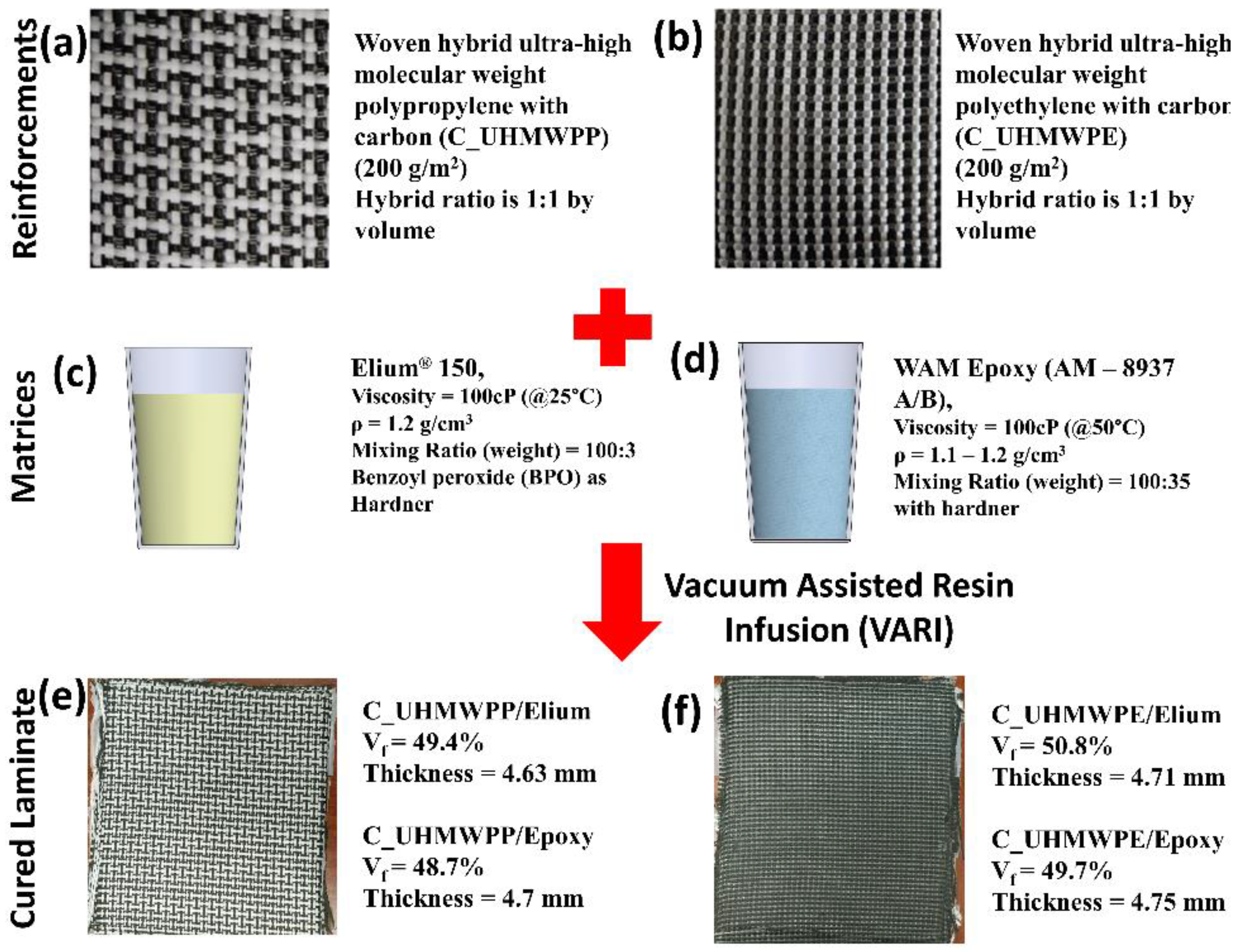
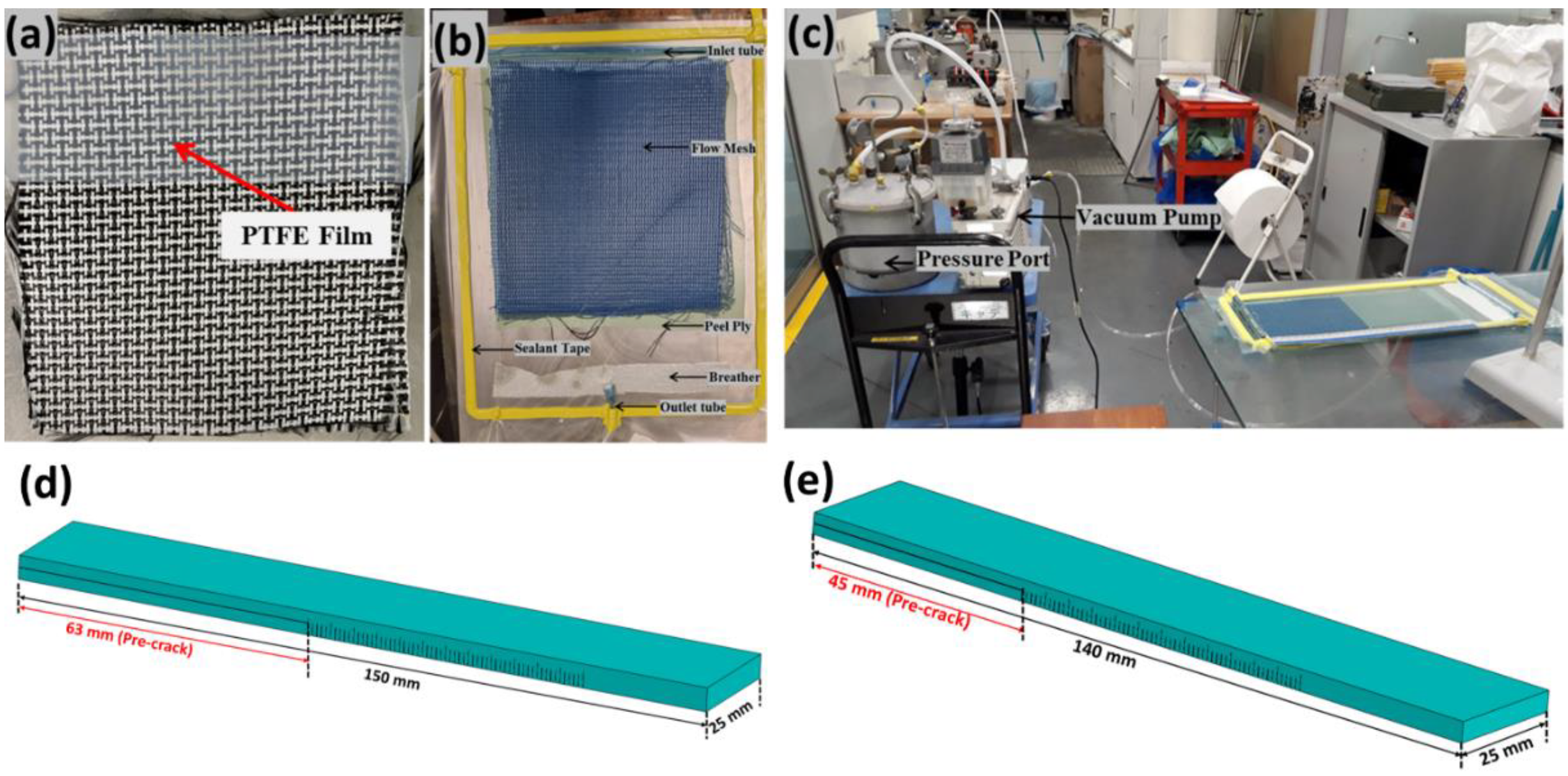
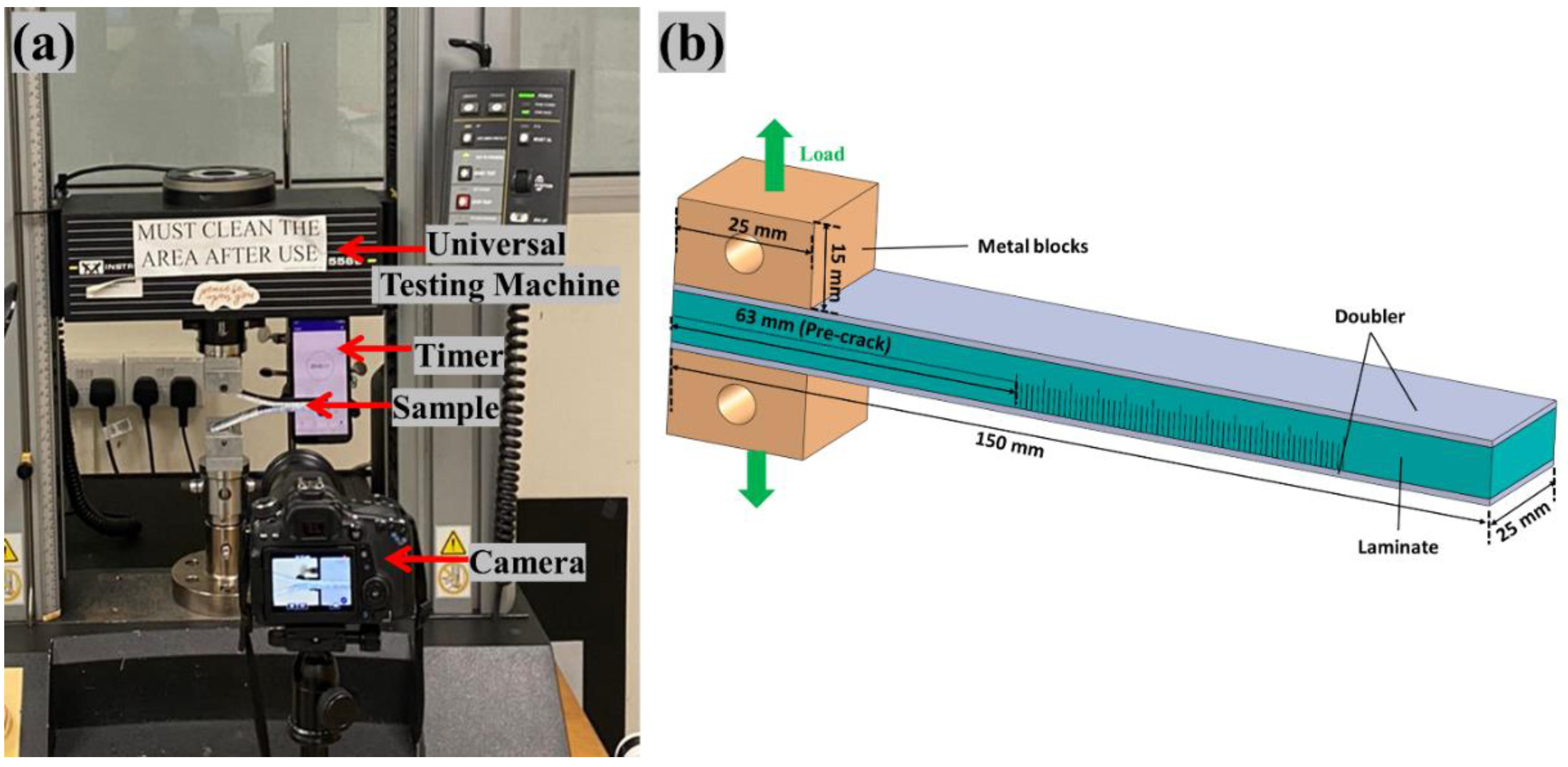
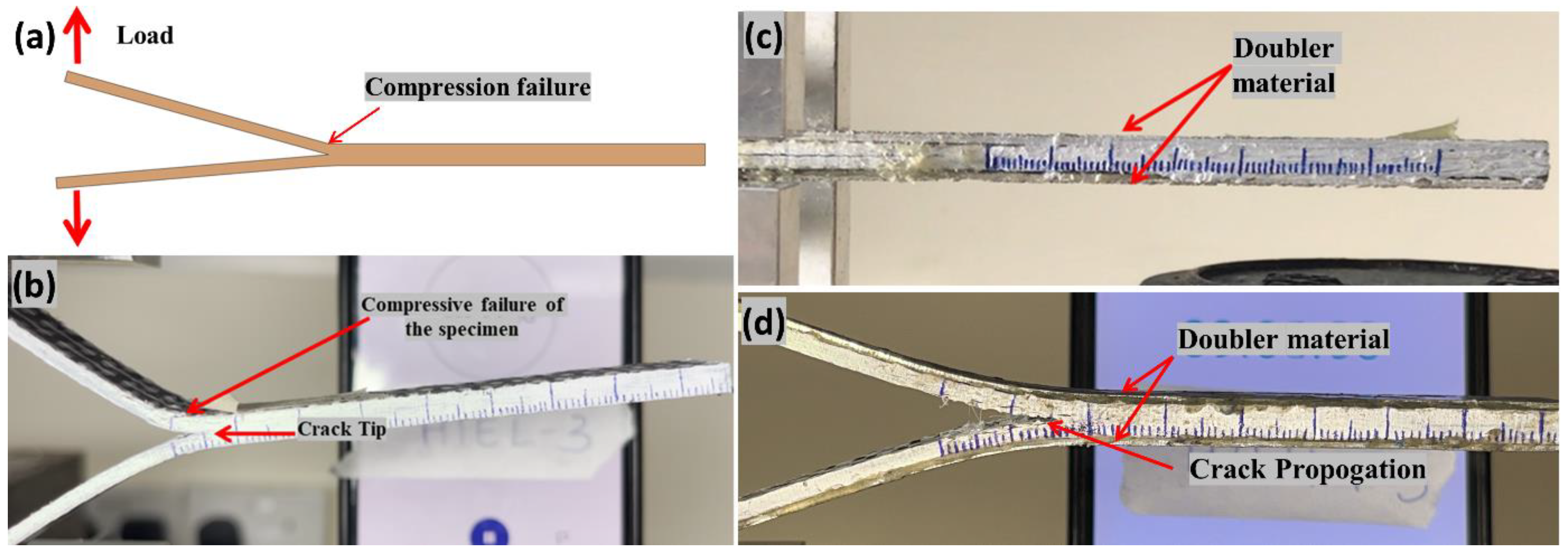

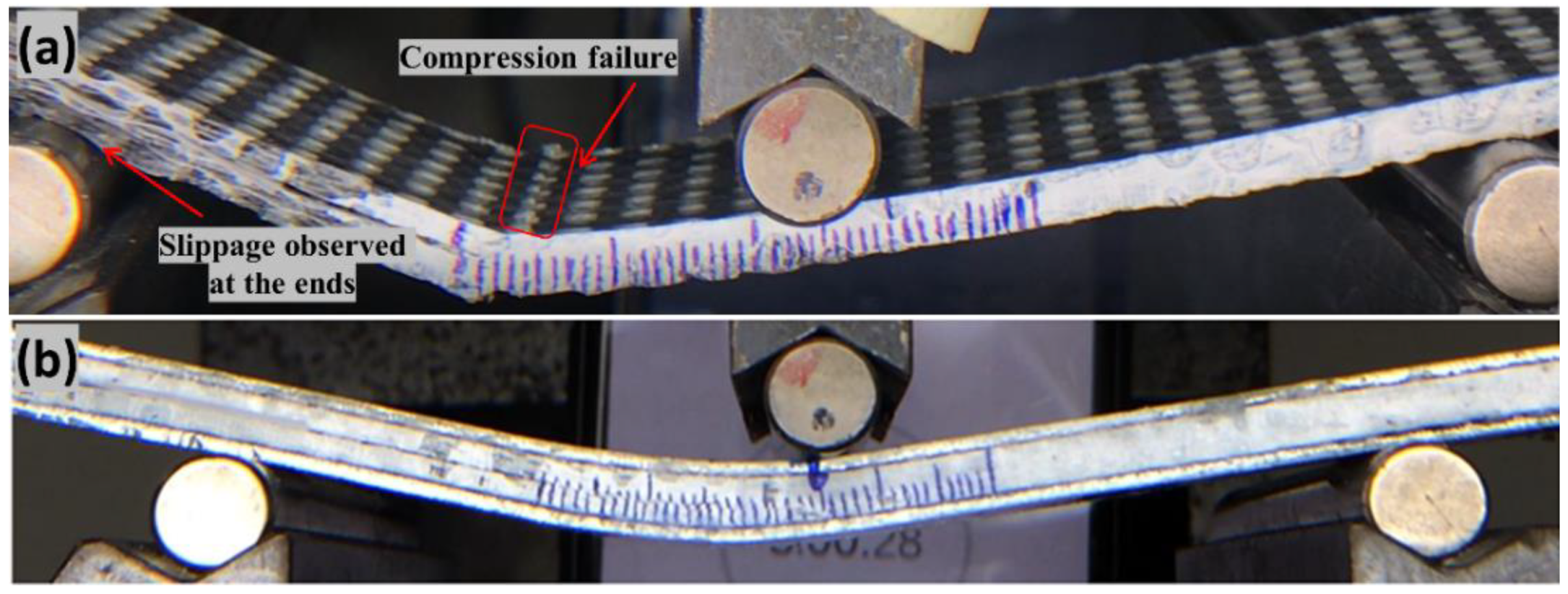
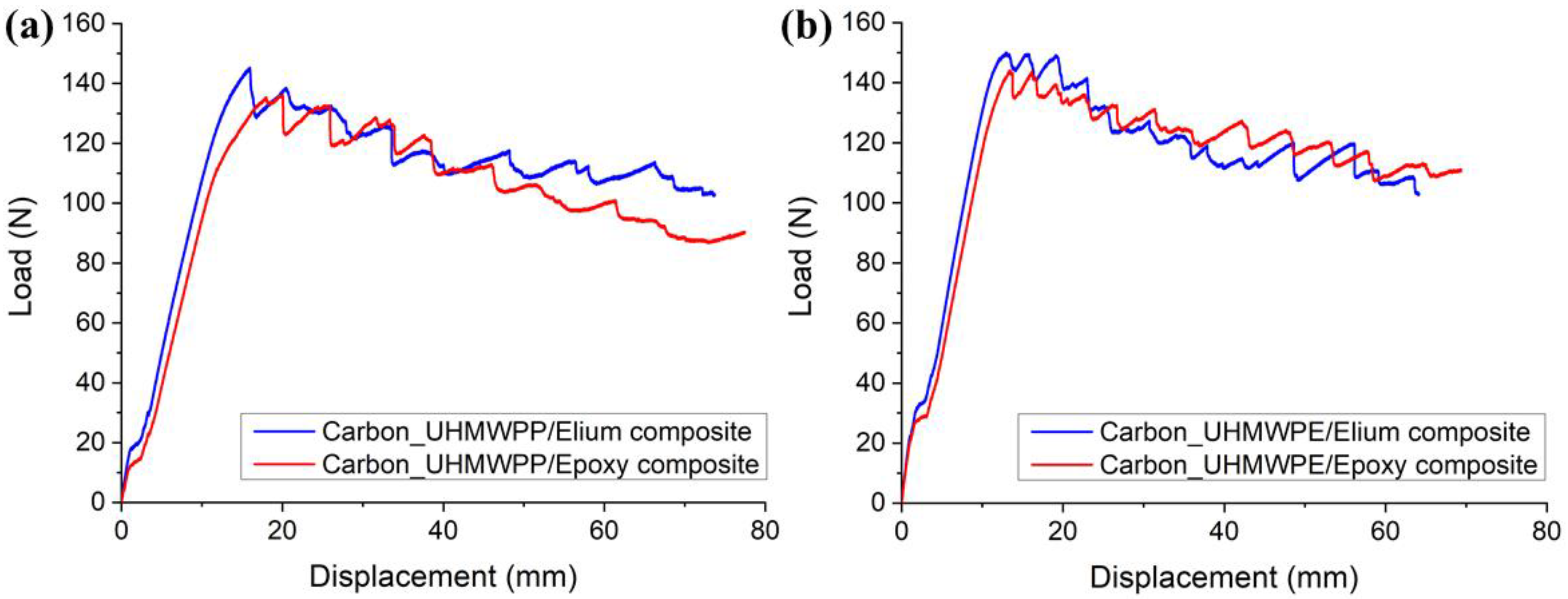
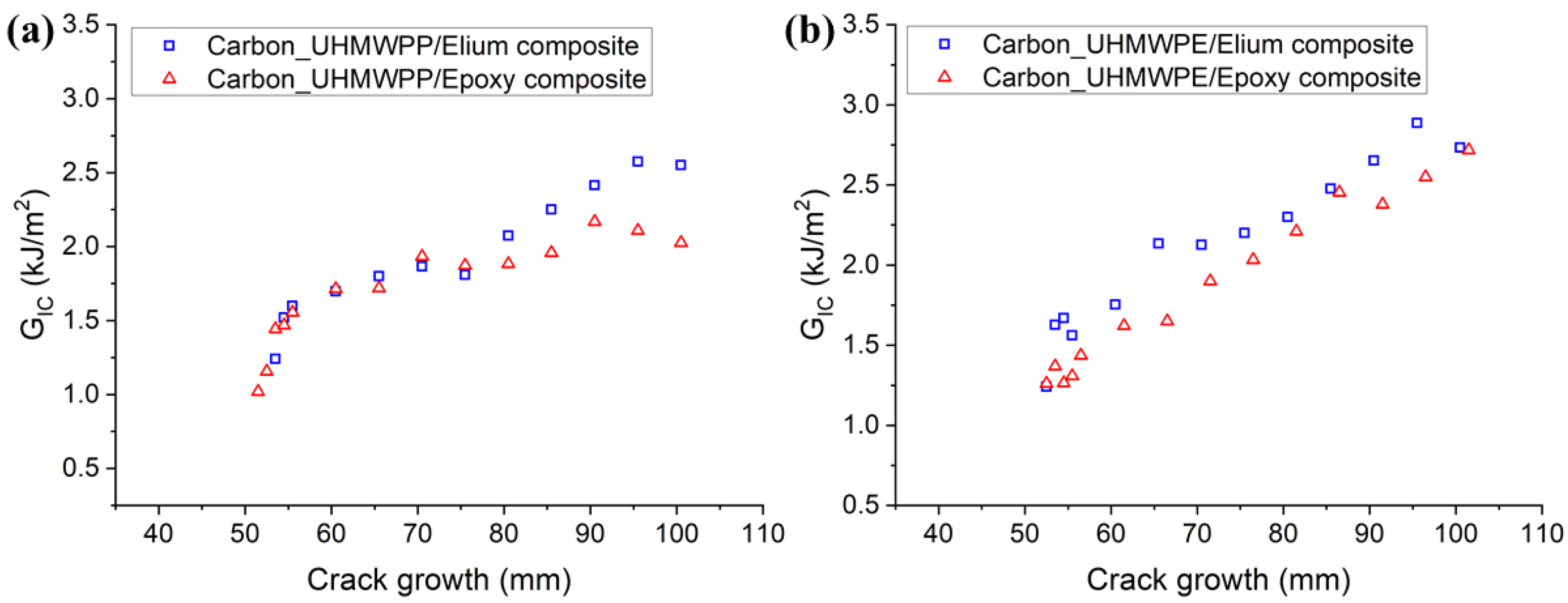
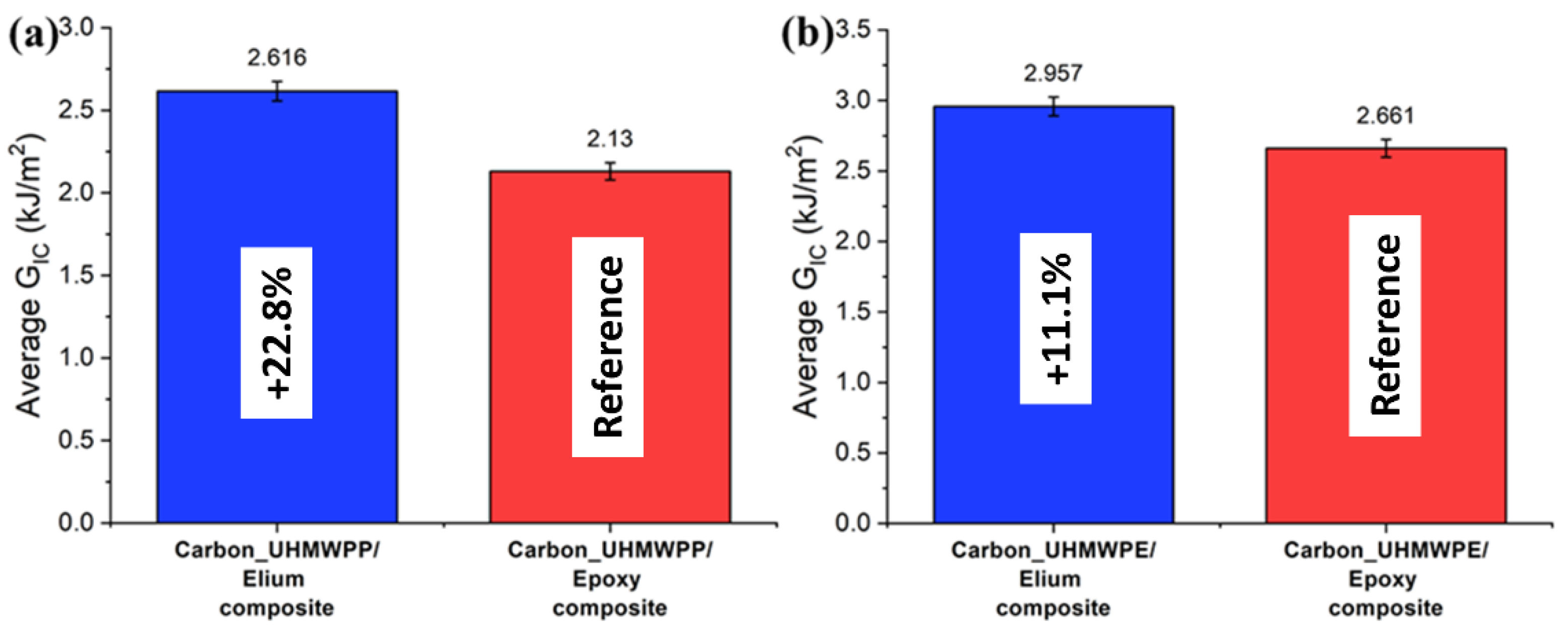
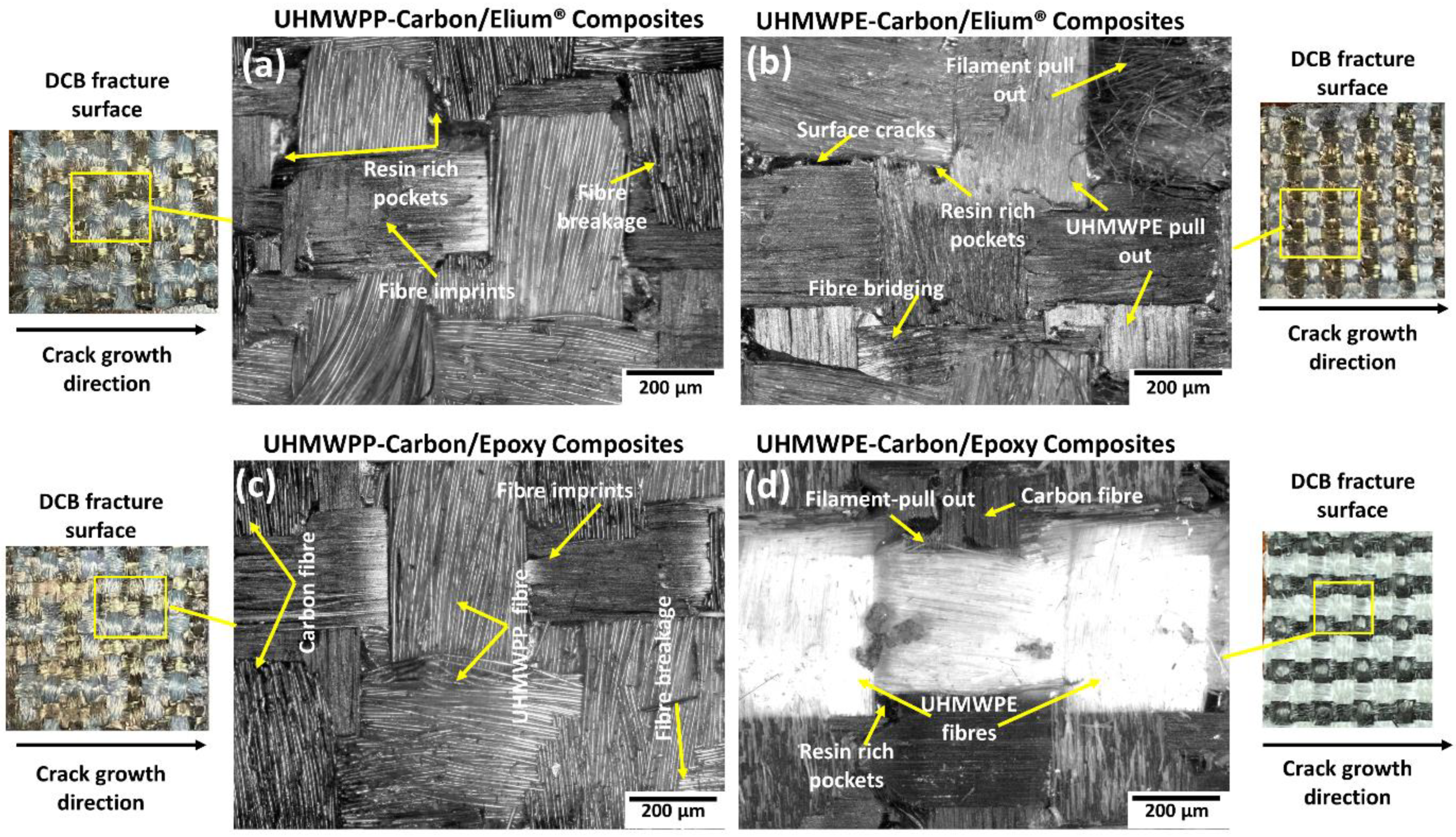
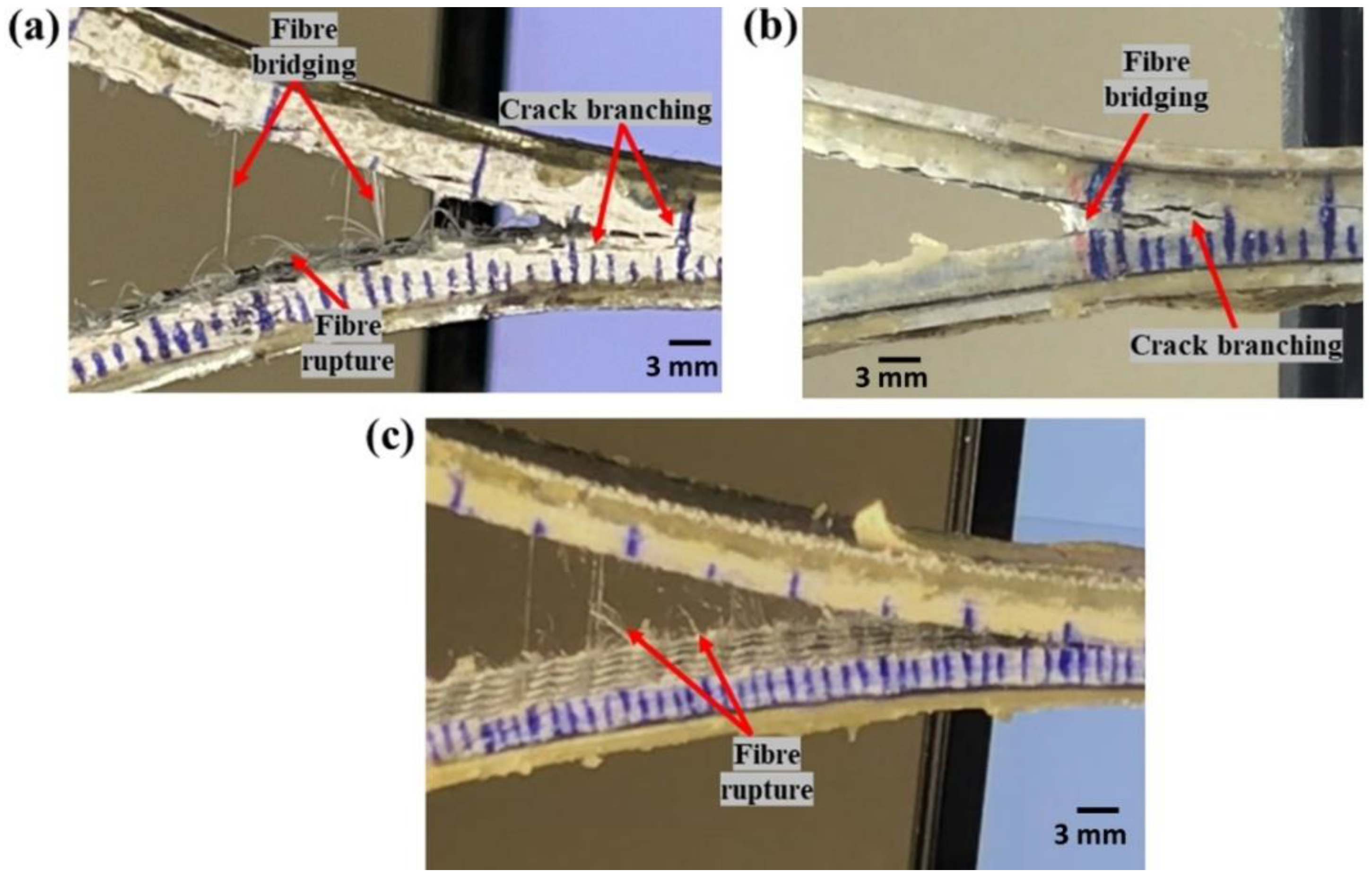
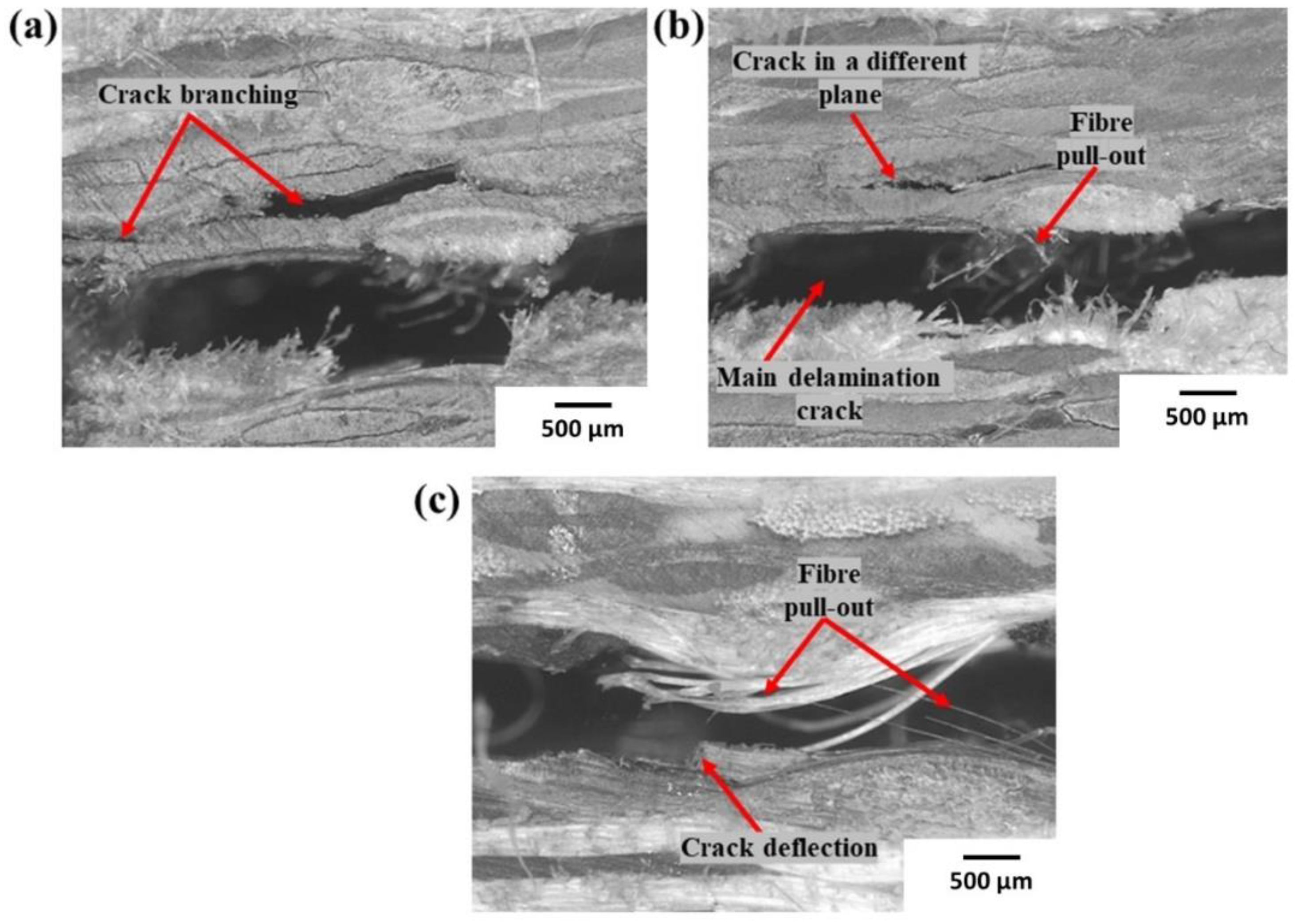
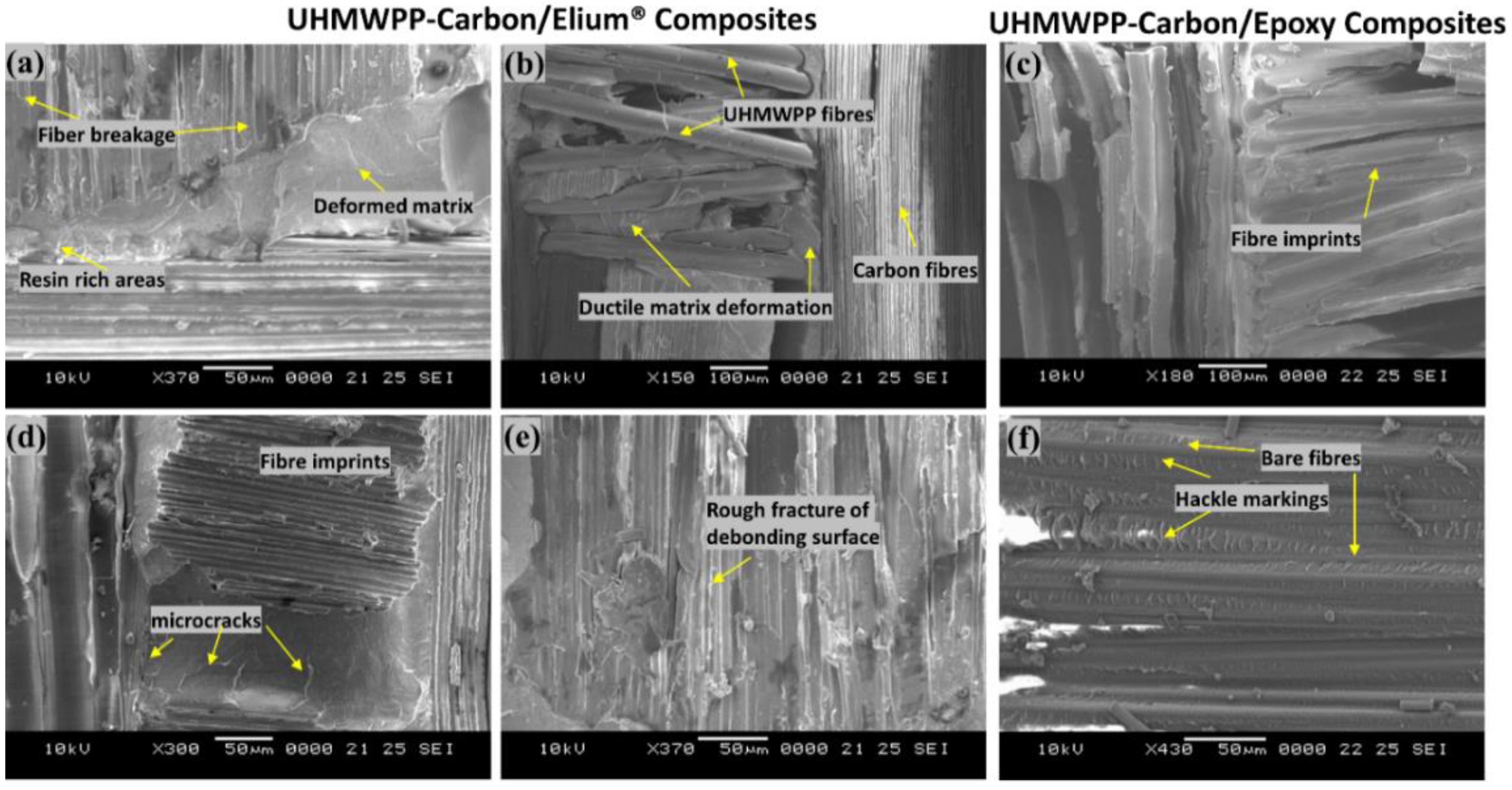
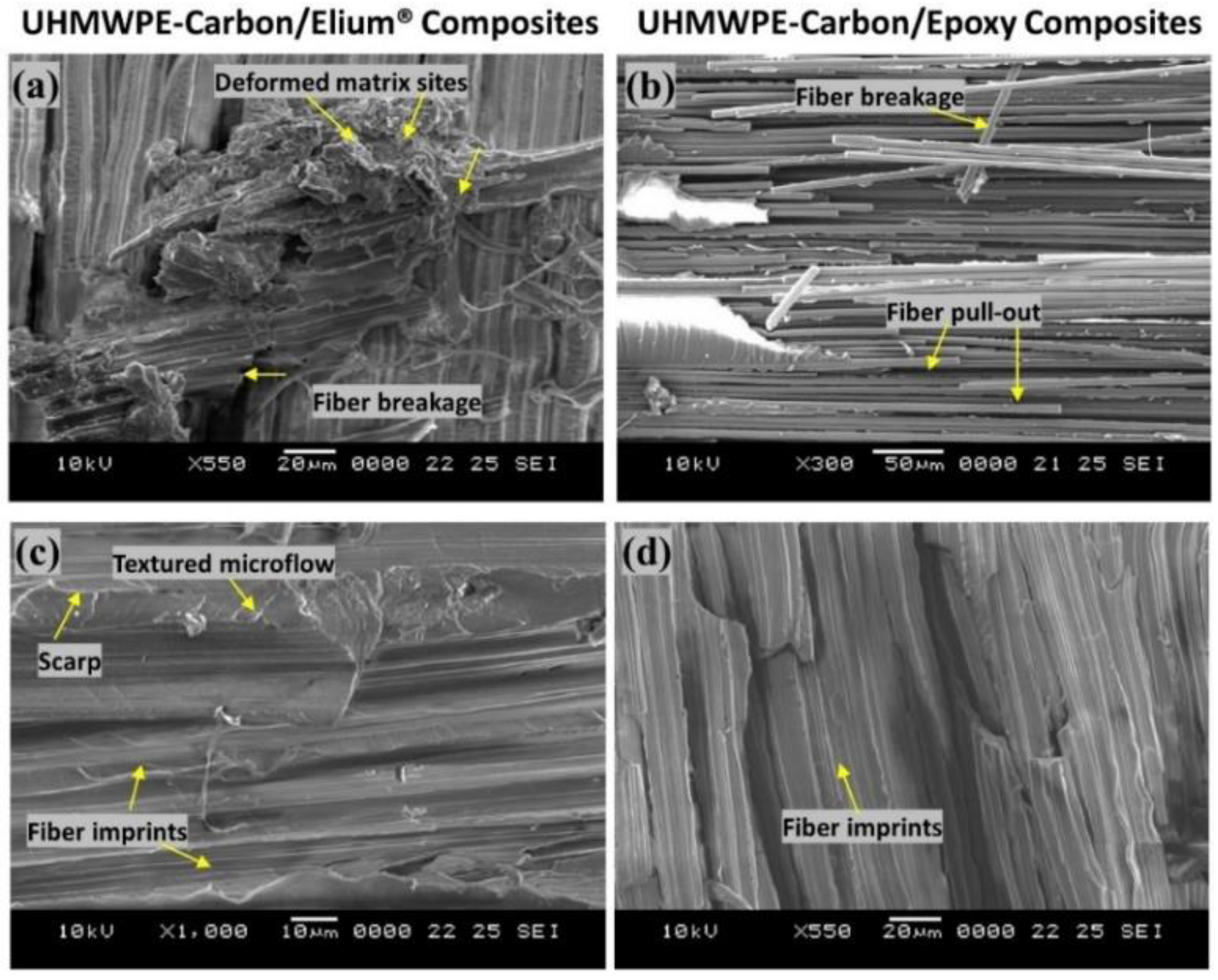
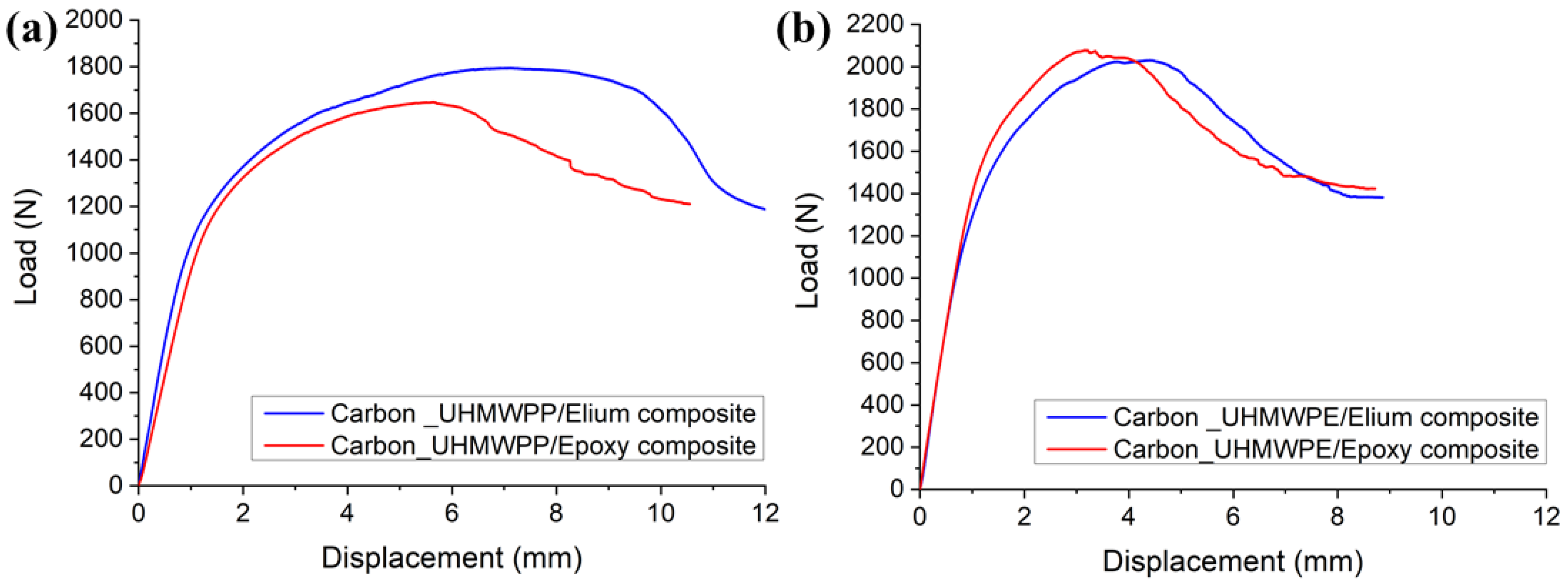
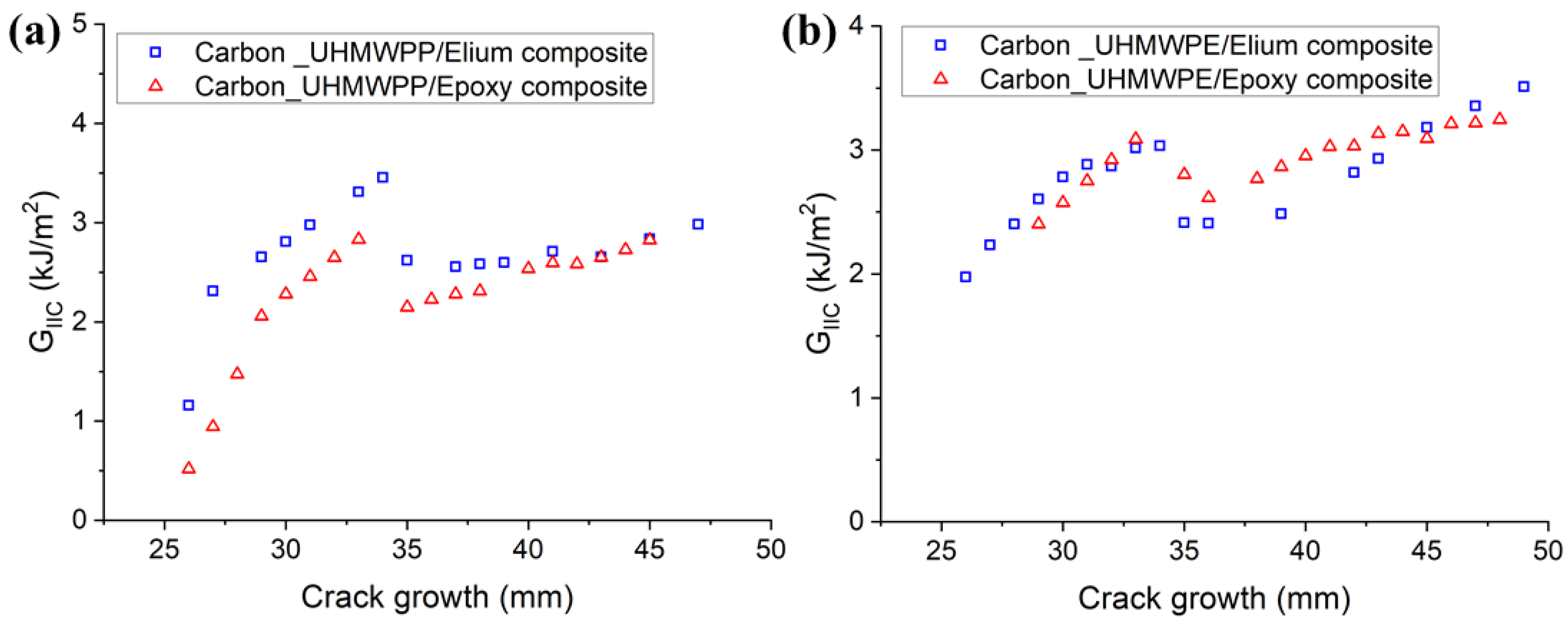
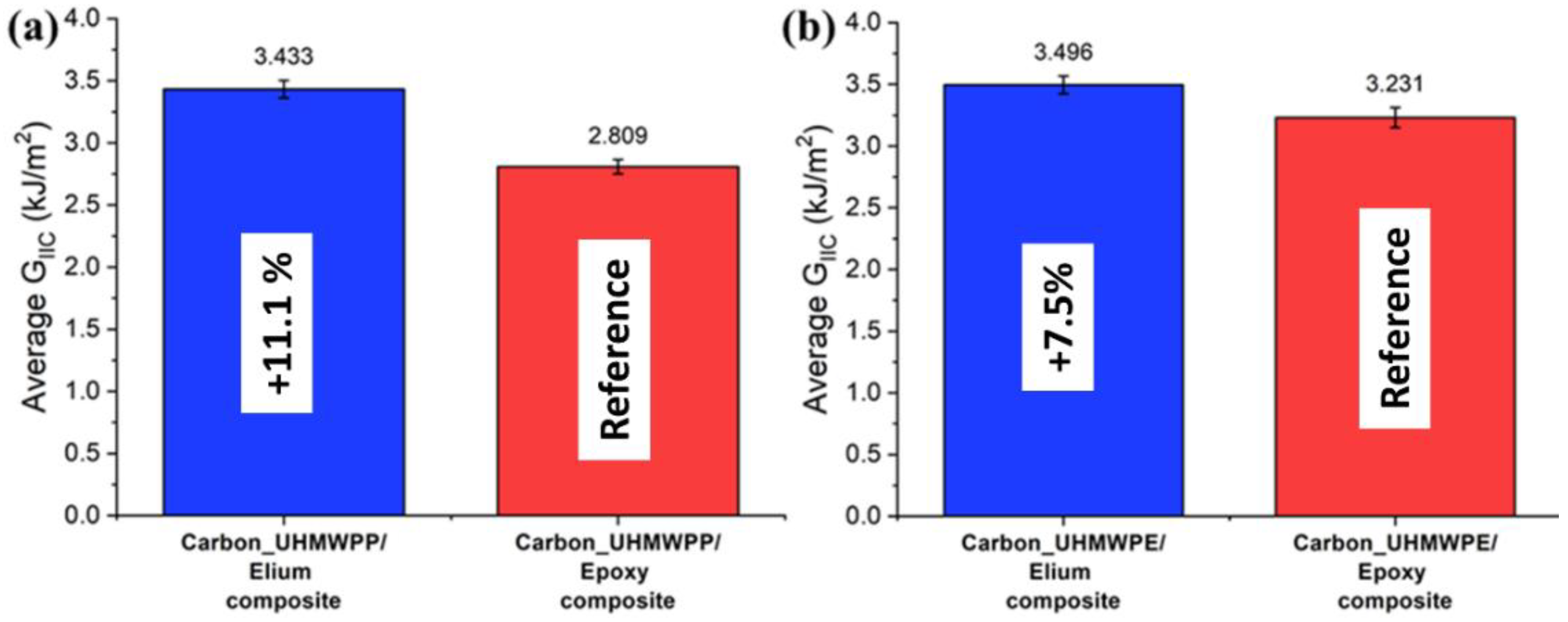

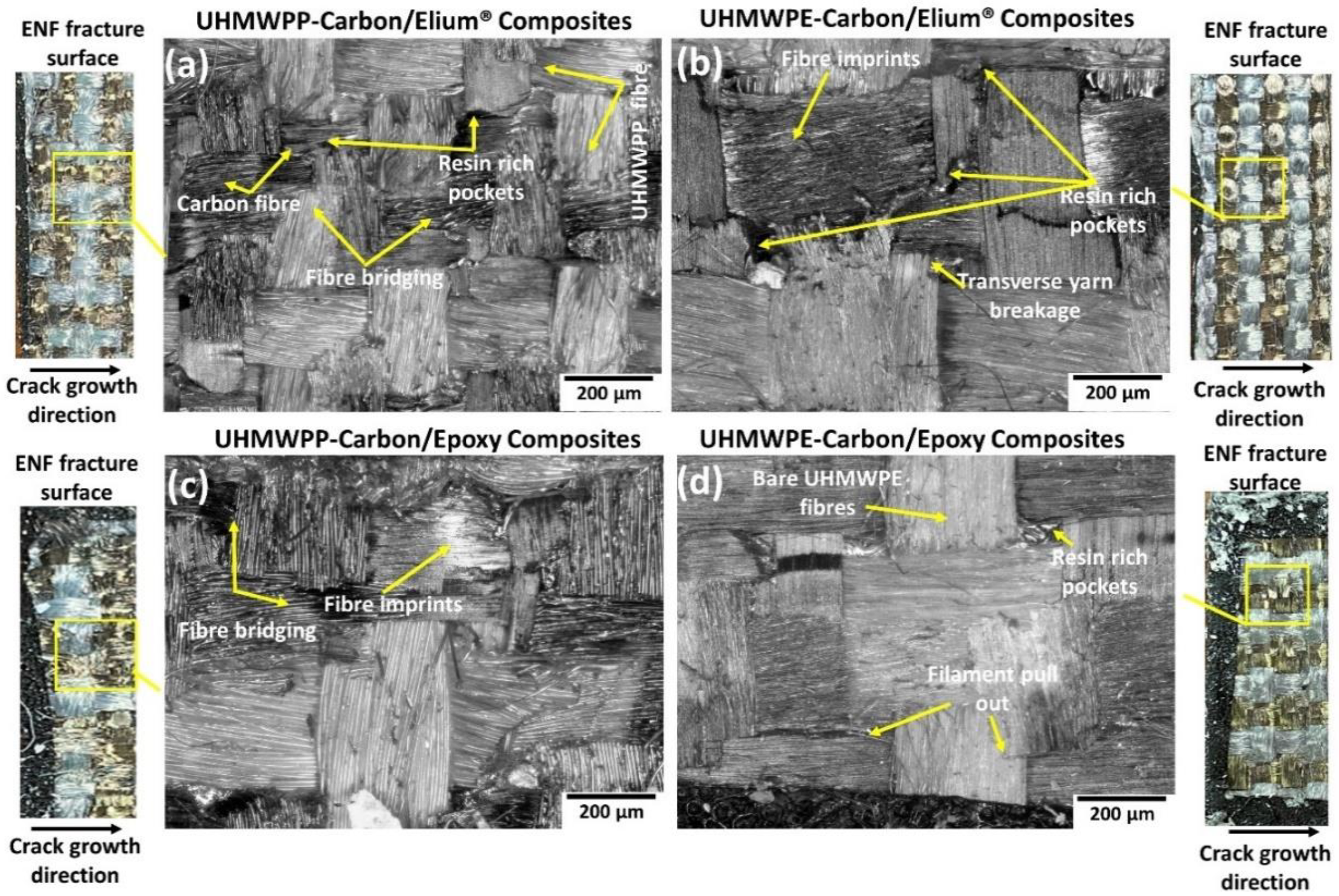
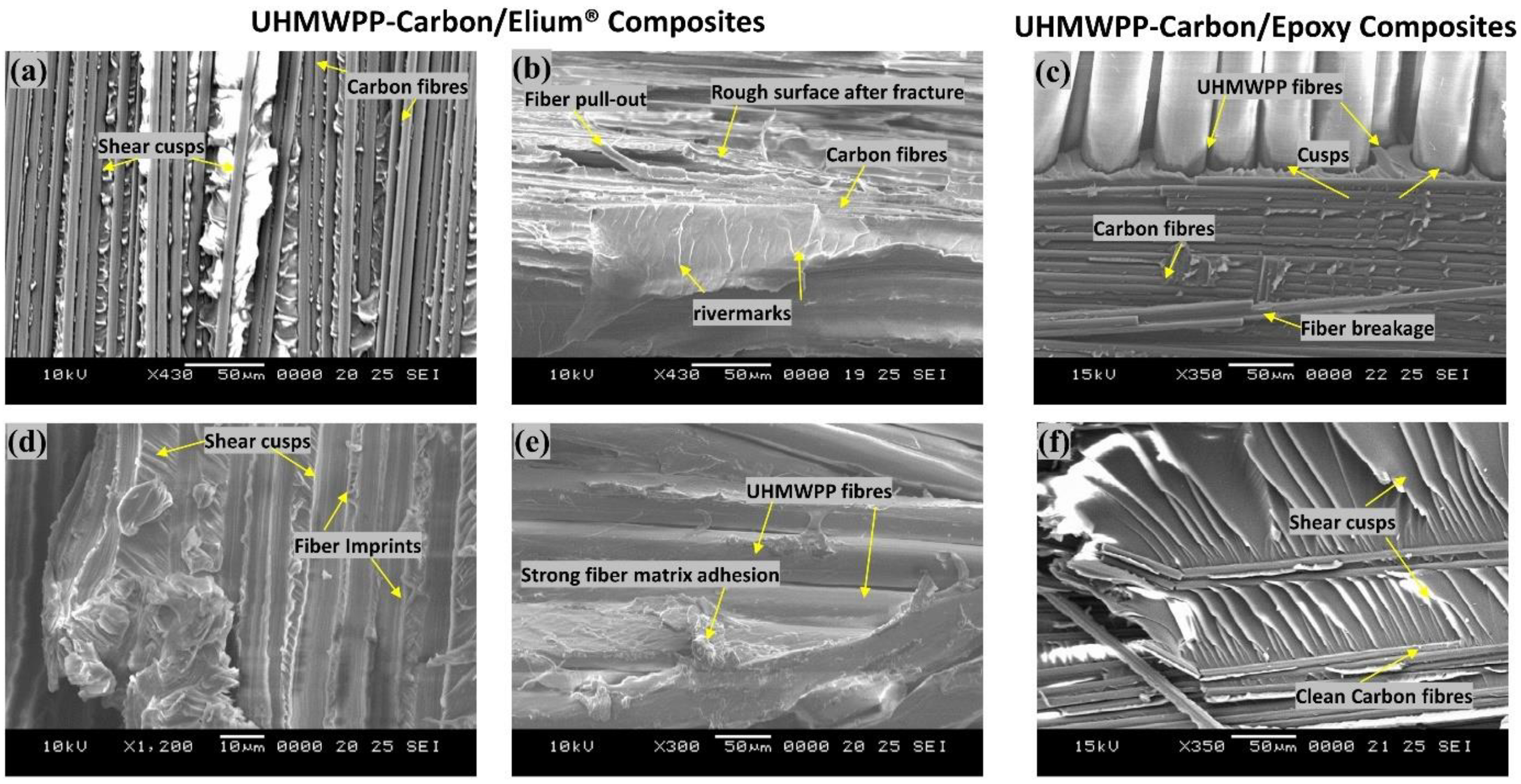
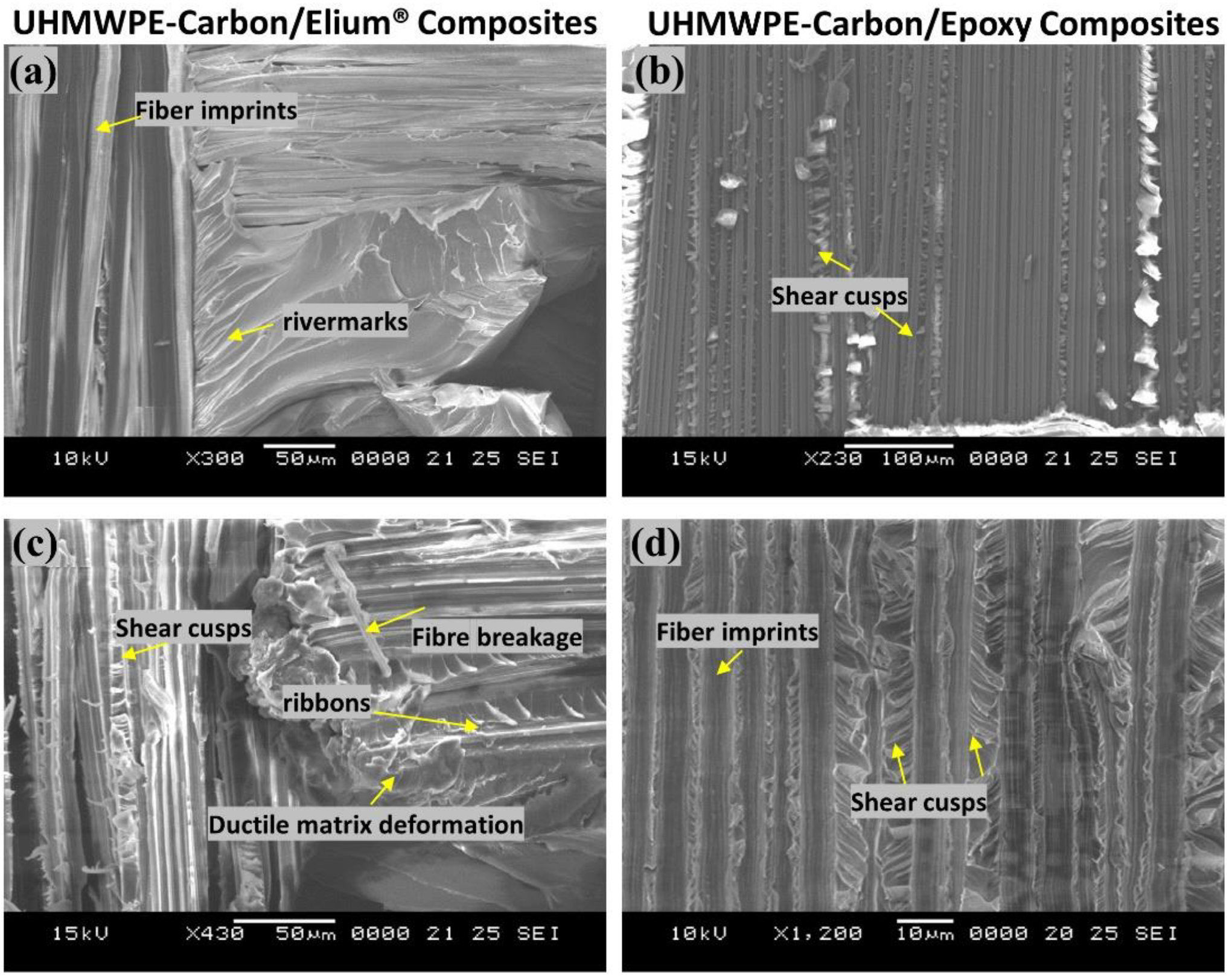
| Reinforcement System | Resin System | Layers | Fiber Volume Fraction (%) | Thickness (mm) | Terminology |
|---|---|---|---|---|---|
| Carbon-UHMWPP | WAM Epoxy | 12 | 48.7 | 7.3 | Carbon_UHMWPP/Epoxy |
| Elium® | 49.4 | 7.2 | Carbon_UHMWPP/Elium® | ||
| Carbon-UHMWPE | WAM Epoxy | 14 | 49.7 | 7.3 | Carbon_UHMWPE/Epoxy |
| Elium® | 50.8 | 7.2 | Carbon_UHMWPE/Elium® |
Publisher’s Note: MDPI stays neutral with regard to jurisdictional claims in published maps and institutional affiliations. |
© 2022 by the authors. Licensee MDPI, Basel, Switzerland. This article is an open access article distributed under the terms and conditions of the Creative Commons Attribution (CC BY) license (https://creativecommons.org/licenses/by/4.0/).
Share and Cite
Bhudolia, S.K.; Gohel, G.; Vasudevan, D.; Leong, K.F.; Gerard, P. On the Mode I and Mode II Delamination Characteristics and Surface Morphological Aspects of Composites with Carbon-Thermoplastic Hybrid Fabrics and Innovative Liquid Thermoplastic Resin. Polymers 2022, 14, 4155. https://doi.org/10.3390/polym14194155
Bhudolia SK, Gohel G, Vasudevan D, Leong KF, Gerard P. On the Mode I and Mode II Delamination Characteristics and Surface Morphological Aspects of Composites with Carbon-Thermoplastic Hybrid Fabrics and Innovative Liquid Thermoplastic Resin. Polymers. 2022; 14(19):4155. https://doi.org/10.3390/polym14194155
Chicago/Turabian StyleBhudolia, Somen K., Goram Gohel, Durga Vasudevan, Kah Fai Leong, and Pierre Gerard. 2022. "On the Mode I and Mode II Delamination Characteristics and Surface Morphological Aspects of Composites with Carbon-Thermoplastic Hybrid Fabrics and Innovative Liquid Thermoplastic Resin" Polymers 14, no. 19: 4155. https://doi.org/10.3390/polym14194155
APA StyleBhudolia, S. K., Gohel, G., Vasudevan, D., Leong, K. F., & Gerard, P. (2022). On the Mode I and Mode II Delamination Characteristics and Surface Morphological Aspects of Composites with Carbon-Thermoplastic Hybrid Fabrics and Innovative Liquid Thermoplastic Resin. Polymers, 14(19), 4155. https://doi.org/10.3390/polym14194155







